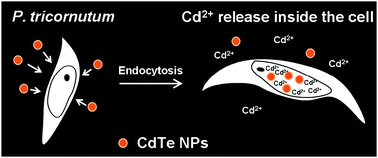Free cadmium ions released from CdTe-based nanoparticles and their cytotoxicity on Phaeodactylum tricornutum†
Abstract
The risk of

* Corresponding authors
a
Department of Chemistry and the MOE Key Laboratory of Analytical Sciences, College of Chemistry and Chemical Engineering, Xiamen University, Xiamen 361005, China
E-mail:
lmyang@xmu.edu.cn, qqwang@xmu.edu.cn
Fax: +86 592 2187400
Tel: +86 592 2181796
b State Key Laboratory of Marine Environmental Science, Xiamen University, Xiamen 361005, China
c Department of Chemical Engineering and Technology, College of Chemistry and Chemical Engineering, Hei Longjiang University, Harbin 150000, China
The risk of

 Please wait while we load your content...
Something went wrong. Try again?
Please wait while we load your content...
Something went wrong. Try again?
 Fetching data from CrossRef.
Fetching data from CrossRef.
This may take some time to load.
Loading related content
